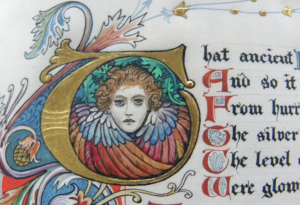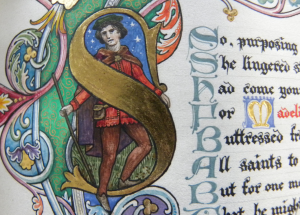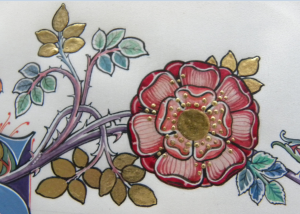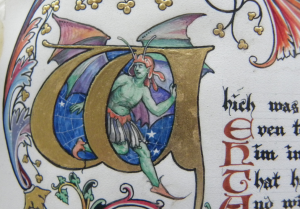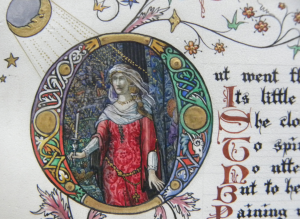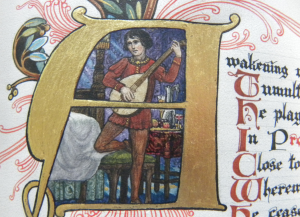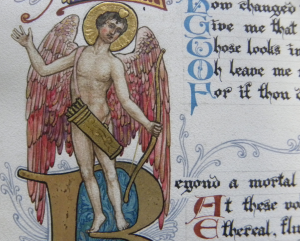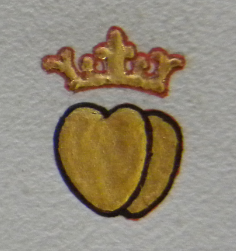140th ANNIVERSARY OF HIS BIRTH
THE EVE OF SAINT AGNES – RECENT ACQUISITION AT CENTRE FOR RESEARCH COLLECTIONS, EDINBURGH UNIVERSITY LIBRARY
 Saturday 10 October 2015 marks the 140th anniversary of the birth of Charles Oppenheimer, craftsman and artist. Oppenheimer was born in Chorlton-upon-Medlock, Manchester, on 10 October 1875. He was a prize-winning student at Manchester School of Art, and his first picture was exhibited at the Manchester Academy of Fine Arts in 1894. His studies also took him to Italy.
Saturday 10 October 2015 marks the 140th anniversary of the birth of Charles Oppenheimer, craftsman and artist. Oppenheimer was born in Chorlton-upon-Medlock, Manchester, on 10 October 1875. He was a prize-winning student at Manchester School of Art, and his first picture was exhibited at the Manchester Academy of Fine Arts in 1894. His studies also took him to Italy.
![]() After marriage in 1903, and after discovering – for him anyway – the acceptable light of Kirkcudbright he moved with his wife to Scotland in 1908 joining other artists in this community in south-western Scotland. By this time Oppenheimer had established himself, having exhibited his first picture at the Royal Academy, London, in 1906.
After marriage in 1903, and after discovering – for him anyway – the acceptable light of Kirkcudbright he moved with his wife to Scotland in 1908 joining other artists in this community in south-western Scotland. By this time Oppenheimer had established himself, having exhibited his first picture at the Royal Academy, London, in 1906.
![]() Other works over six decades include: The Lion of St. Mark, Venice, exhibited 1898, and illuminated manuscript of the poem by John Keats The Eve of St. Agnes (c. 1901), Kircudbright Harbour (c. 1910), Kirkcudbright (c. 1913), Verona (1914), Morning mist – Lake of Lugano (c. 1925), Siena at dusk (c. 1929), San Francesco, Assisi (1930s), and Blossom, Buckland Burn (c. 1940).
Other works over six decades include: The Lion of St. Mark, Venice, exhibited 1898, and illuminated manuscript of the poem by John Keats The Eve of St. Agnes (c. 1901), Kircudbright Harbour (c. 1910), Kirkcudbright (c. 1913), Verona (1914), Morning mist – Lake of Lugano (c. 1925), Siena at dusk (c. 1929), San Francesco, Assisi (1930s), and Blossom, Buckland Burn (c. 1940).
Recently, Edinburgh University Library acquired the illuminated handwritten manuscript crafted by Charles Oppenheimer of the poem The Eve of Saint Agnes, by John Keats. The bound volume is of thirteen pages of vellum – ‘a prodigious piece of work’ – and demonstrates Oppenheimer’s craftsmanship, skill and drawing. It is not known whether the item was a commission, an academic exercise or business sample.
Saint Agnes’ Eve – Ah, bitter chill it was! The owl, for all his feathers, was a-cold… stanza 1
The Eve of Saint Agnes was written by John Keats in 1819 and it was published in 1820, becoming one of his finest poems. Keats based his poem on the superstition that a girl could see her future husband in a dream if she performed certain rites on the eve of St. Agnes. In the 42-stanza poem we meet an old man of prayer (a beadsman), many an amarous cavalier, Madeline, old Angela, and Porphyro.
The carved angels, ever eager-eyed, stared, where upon their heads the cornice rests… stanza 4
Meantime, across the moors, had come young Porphyro, with heart on fire for Madeline… stanza 9
Sudden a thought came like a full-blown rose, flushing his brow, and in his pained heart made purple riot… stanza 16
While legioned fairies paced the coverlet, and pale enchantment held her sleepy-eyed… stanza 19
Out went the taper as she hurried in; its little smoke, in pallid moonshine died… stanza 23
Awakening up, he took her hollow lute – tumultuous – and, in chords that tenderest be, he played an ancient ditty… stanza 33
At these voluptuous accents, he arose, ethereal, flushed, and like throbbing star… stanza 36
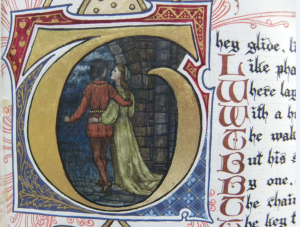
Down the dark stairs a darkling way they found, from ‘The Eve of Saint Agnes’, Charles Oppenheimer, 1901
They glide, like phantoms, into the wide hall; like phantoms, to the iron porch, they glide… stanza 41
![]() Charles Oppenheimer exhibited at the Royal Academy in London, the Royal Scottish Academy, at the Royal Scottish Academy of Painters in Watercolours (RSW), at the Royal Glasgow Institute of Fine Arts, the Aberdeen Artists’ Society, and in Liverpool. He designed a number of posters for Britain’s railways, depicting local beauty spots, and he also designed the badge and motto ‘Sempere Vigilo’ of the Scottish Police Force (now Police Scotland).
Charles Oppenheimer exhibited at the Royal Academy in London, the Royal Scottish Academy, at the Royal Scottish Academy of Painters in Watercolours (RSW), at the Royal Glasgow Institute of Fine Arts, the Aberdeen Artists’ Society, and in Liverpool. He designed a number of posters for Britain’s railways, depicting local beauty spots, and he also designed the badge and motto ‘Sempere Vigilo’ of the Scottish Police Force (now Police Scotland).
Charles Oppenheimer died in Kirkcudbright on 16 April 1961.
Dr. Graeme D. Eddie, Assistant Librarian Archives & Manuscripts, Centre for Research Collections, Edinburgh University Library
![]() The following work was referred to in the creation of this blog-post:
The following work was referred to in the creation of this blog-post:
Charles Oppenheimer. From craftsman to artist, by Euan Robson. Edinburgh: Atelier Books, 2012.

